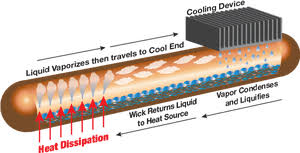Heat Pipes
Heat Pipes
Heat-pipe or thermal-pipe is a device which is capable of long distances heat transfer at very low temperature losses.
The heat pipe is composed of a tube the internal envelope thereof is covered by a thin layer of porous wick which enable water to flow capillary in the wick from one end of the heat pipe to the other end.
The wick is saturated with water after which the heat pipe is sealed under vacuum which keep the heat pipe internally at a pressure much below the atmospheric pressure.
When a section of the heat pipe, referred to as the evaporator, is warmed up, such as by a hot component, the water within the wick under the low pressure evaporate at low temperature absorbing the evaporating heat from the component.
The vapor is flowing quickly to the cold end(s) and warms them up where the heat is removed from the vapor in the cold ends for example by an air cooled heat sink or water cooled cold plate. The removal of heat condense back the vapor into water in the condenser section.
Due to the capillary pressure existing between the saturated condenser and the dry evaporator the water will flow capillary back to the evaporator where they will be evaporated again and flow back to the condenser as vapor.
The main temperature drop is at the condenser and evaporator sections while the flow of the vapor along the heat-pipe is causing very little temperature drop in the range of 1 degrees regardless the length of the heat-pipe.
Heat pipes are used to transfer heat from a place where there is no possibility and means to remove it to a place where the heat can be removed. Another common use of heat pipes to turn the base of heat sinks isothermals such as the base of a large heat sinks with concentrated heat source which increase the heat dissipation capacity of the heat sink without the need of changing its dimensions or increasing the air flow pattern in-between the fins

